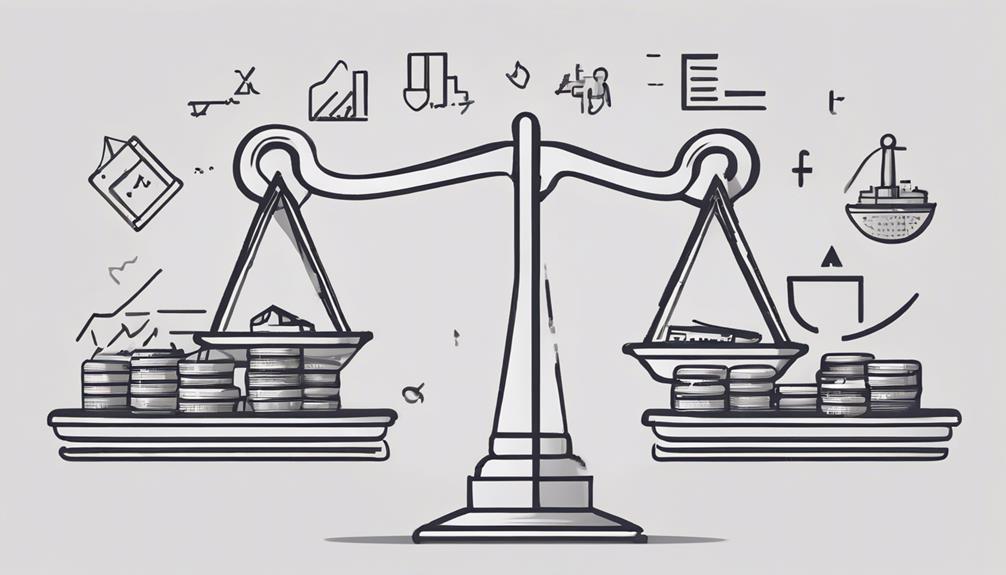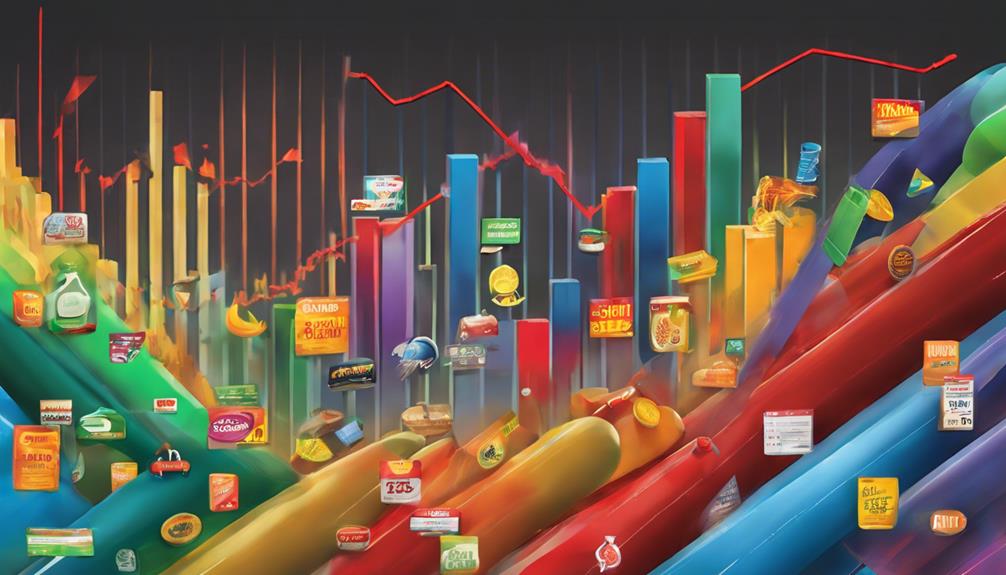The fluctuation of prices in the market is a complex interplay of multiple factors that impact the economic landscape. From the fundamental principles of supply and demand to the intricate web of consumer behavior, production costs, and external influences, the reasons behind the rise and fall of prices are rooted in a dynamic and ever-evolving system. Understanding these various elements provides a glimpse into the intricate mechanisms that drive price adjustments, offering a deeper insight into the mechanisms that shape our commercial world.
Key Takeaways
- Supply and demand dynamics drive price fluctuations.
- Cost of production changes influence pricing strategies.
- Market competition and brand loyalty impact pricing.
- External factors like government interventions and currency fluctuations affect prices.
Supply and Demand Dynamics

Supply and demand dynamics form the fundamental economic principle that governs the pricing mechanisms of goods and services in a market economy. The interaction between supply and demand directly influences prices. When the demand for consumer goods exceeds the available supply, prices tend to increase due to scarcity. This scenario often leads to inflation, as consumers are willing to pay more for the limited goods or services. On the other hand, if the supply of a product surpasses consumer demand, prices usually decrease as sellers try to attract buyers by offering competitive pricing. Understanding these fluctuations in prices is essential for both consumers and producers in making informed decisions. Shifts in supply and demand curves can result in significant price changes, impacting the cost of goods and services in the market. Therefore, monitoring supply and demand dynamics is critical for predicting and responding to price variations effectively.
Cost of Production Changes
Changes in the cost of production play a crucial role in determining the pricing of goods and services in a market economy. Production costs are influenced by various factors, including raw material prices, labor costs, energy prices, exchange rates, technological advancements, and government regulations. Fluctuations in raw material prices or labor costs can directly impact the overall production expenses, leading to adjustments in prices. Similarly, changes in energy prices, such as those of oil and gas, can significantly affect production costs, resulting in price fluctuations in the market. Shifts in exchange rates also play a vital role as they can impact the cost of imported materials or components, thereby influencing production costs. Moreover, technological advancements and innovations in production processes can lower costs, potentially leading to price reductions for consumers. It is essential for businesses to monitor these cost factors closely to adapt their pricing strategies accordingly and remain competitive in the market.
Market Competition Impact

Market competition plays a significant role in influencing prices as businesses vie for consumer attention through competitive pricing strategies. Price wars, driven by this competitive environment, can lead to temporary reductions in prices as companies battle for market dominance. Additionally, the interplay between supply and demand, alongside the influence of brand loyalty, further shapes how market competition impacts pricing dynamics.
Price Wars Effect
Engaging in fierce competition through price wars can have significant impacts on market dynamics and the participating businesses' financial performance. Price wars, characterized by competitors lowering prices to gain market share, can lead to temporary price decreases benefiting consumers. However, businesses involved may experience lower profit margins due to the intense competition. To stay competitive, companies may prioritize cost-cutting measures, potentially compromising product quality. While consumers enjoy access to lower-priced goods and services during price wars, businesses must carefully balance the short-term benefits of attracting customers with the long-term financial implications. It is essential for companies to strategically navigate price wars to maintain profitability and market position amidst intense competition.
Supply and Demand
In analyzing the impact of market competition on price fluctuations, an essential factor to consider is the interplay between supply and demand dynamics. When demand surpasses supply in a market, prices tend to rise, allowing businesses to capitalize on maximizing profits. Conversely, if supply exceeds demand, prices may fall as companies adjust to clear excess inventory and encourage consumer spending. Competition among businesses can trigger price wars, where companies lower prices to gain market share, ultimately benefiting consumers through lower prices. Understanding these supply and demand dynamics is crucial in comprehending how market competition influences price variations across different industries and sectors.
| Demand | Supply | Prices |
|---|---|---|
| Exceeds | Surpasses | Rise |
| Surpasses | Exceeds | Fall |
| Competition | Market | Impact |
Brand Loyalty Influence
Analyzing the impact of brand loyalty on market competition reveals a crucial aspect of consumer behavior that significantly influences pricing strategies. Brand loyalty can create a loyal customer base that is often less price-sensitive, allowing companies to maintain higher prices based on customer preference. This loyalty can result in less fluctuation in prices, as customers are willing to pay more for trusted brands. Market competition plays a vital role in shaping brand loyalty, as companies use pricing strategies to differentiate themselves and retain customers. Understanding the relationship between brand loyalty and market competition is crucial for businesses to navigate pricing dynamics effectively and stay competitive in the market.
Changes in Consumer Preferences

Consumer preferences drive significant fluctuations in prices of goods and services by influencing the demand dynamics within the market. Changes in consumer preferences directly impact the prices of goods by affecting the level of demand for specific products or services. For instance, a shift towards health-conscious choices can lead to an increased demand for organic products, thereby driving up their prices. Conversely, if consumers show a decreased interest in a particular item due to changing trends, its price may decrease to stimulate demand. Availability and pricing of goods in the market are closely tied to consumer preferences, as businesses strive to align their offerings with what customers desire. Market research and consumer feedback are crucial in understanding these preferences, guiding businesses in adjusting their pricing strategies accordingly. Brands often adapt their products and pricing to cater to evolving consumer behaviors, ensuring they remain competitive in the market driven by consumer demand fluctuations.
Economic Conditions Influence
Economic factors exert significant influence on the pricing dynamics of goods and services in the market. Changes in the supply chain, consumer demand, and production costs contribute to the fluctuations in prices. When the demand for a product exceeds its supply, it can lead to demand-pull inflation, causing prices to go up. On the other hand, if production costs increase due to factors like rising raw material prices or wages, it can result in cost-push inflation, driving prices higher. Additionally, monetary policy, such as changes in interest rates by central banks, can impact inflation rates and subsequently influence price levels. The Consumer Price Index (CPI) is a key indicator used to measure inflation, reflecting how prices go up or down over time. Therefore, understanding these economic conditions and their interplay is crucial for comprehending the complex nature of price fluctuations in the market.
Government Policies and Regulations

Government interventions through policies and regulations play a pivotal role in shaping the pricing landscape of goods and services within the market. Various government policies and regulations directly influence prices, impacting both consumers and producers.
- Price controls: Governments can set price controls to stabilize prices, prevent price gouging, or ensure affordability for essential items.
- Subsidies: Government subsidies lower production costs for certain goods, leading to reduced consumer prices.
- Tariffs and trade agreements: Interventions like tariffs or trade agreements can affect the cost of imported goods, subsequently influencing overall price levels in the economy.
- Regulatory changes: Changes in regulations, especially in sectors like healthcare or energy, can significantly impact the prices of related products and services.
These interventions are designed to maintain fairness, stability, and affordability within the market, reflecting the government's economic objectives and priorities. By understanding the implications of these policies and regulations, one can grasp the dynamics behind price fluctuations in the market.
Currency Fluctuations Impact
Currency fluctuations play a crucial role in shaping the pricing dynamics of goods and services, influencing both domestic and international market competitiveness. When a country's currency strengthens, the cost of imported goods tends to decrease, leading to lower prices in the domestic market. Conversely, a weaker currency can make imports more expensive, resulting in higher domestic prices. Exchange rate movements not only impact the cost of imported products but also affect the competitiveness of domestic goods in international markets. This, in turn, influences pricing strategies adopted by businesses.
Economies heavily reliant on imports are particularly vulnerable to currency fluctuations, as these fluctuations directly affect consumer purchasing power. Monitoring currency exchange rates becomes essential for investors and businesses to anticipate potential price changes and adjust their pricing strategies accordingly. By staying informed about currency movements, businesses can make informed decisions to maintain competitiveness and adapt to changing market conditions effectively.
Technological Advancements Impact

Technological advancements play a crucial role in influencing price fluctuations by driving innovation and efficiency in production processes. Lower production costs due to automation and enhanced productivity from advanced technologies can lead to price adjustments in the market. Additionally, improvements in supply chain management through digitalization and e-commerce platforms can impact pricing strategies and product availability for consumers.
Tech Innovation Drives Prices
In the realm of economic dynamics, the impact of technological advancements on pricing mechanisms is undeniable and profound.
- Technological advancements can drive prices down by increasing efficiency, reducing production costs, and enhancing productivity.
- Innovation in technology leads to the creation of new products and services, offering consumers more choices at varying price points.
- Disruptive technologies like artificial intelligence and automation can revolutionize industries, causing price fluctuations as markets adapt to new norms.
- Tech innovation can create price volatility as competition intensifies and companies strive to differentiate themselves through pricing strategies.
- The adoption of advanced technologies can lead to price adjustments as businesses seek to capture market share and stay competitive in dynamic environments.
Automation Lowers Production Costs
The impact of automation on production costs is a critical factor in understanding the influence of technological advancements on pricing mechanisms. Automation reduces production costs by enhancing efficiency and productivity. This reduction in costs can lead to price decreases for consumers as companies strive to remain competitive in the market. Additionally, automation facilitates higher productivity levels, enabling businesses to produce more goods at lower costs. Economies of scale can further drive down production costs as automation in manufacturing allows for mass production efficiencies. Overall, the adoption of automation technologies plays a significant role in shaping pricing dynamics and improving competitiveness in various industries.
| Key Points | |
|---|---|
| Automation Efficiency | |
| Higher Productivity Levels | |
| Price Decreases for Consumers | |
| Enhanced Competitiveness |
Supply Chain Efficiency Improves
Enhanced supply chain efficiency due to technological advancements has significantly transformed operational processes in the industry. This transformation has had a direct impact on various aspects of supply chain management, leading to improvements in efficiency and cost-effectiveness. The integration of automation and data analytics has streamlined operations, enhancing visibility and coordination within the supply chain. Furthermore, the utilization of IoT devices and AI algorithms has optimized inventory management, resulting in more accurate forecasting. Enhanced transportation systems and tracking technologies have enabled real-time monitoring and faster delivery of products, contributing to overall cost reduction. Additionally, improved communication tools and cloud-based platforms have facilitated collaboration among supply chain partners, further enhancing the performance of the supply chain.
Global Events and Natural Disasters

Global events and natural disasters play a significant role in disrupting global supply chains and contributing to price fluctuations. Wars, geopolitical tensions, or natural disasters can have profound impacts on global markets, leading to supply chain disruptions and price volatility. For instance, conflicts in key production regions can hinder the production and transportation of goods, causing shortages and subsequent price increases. Geopolitical tensions can also affect global markets, resulting in higher prices for essential goods due to uncertainty and risk factors. Supply chain disruptions caused by global events create scarcity, further driving up prices for affected products. The interconnectedness of economies is highlighted by the price volatility resulting from external shocks, emphasizing how events in one part of the world can have far-reaching effects on prices globally. Understanding the influence of global events and natural disasters on price fluctuations is essential for comprehending the complexities of supply and demand dynamics in a globalized economy.
Frequently Asked Questions
What Causes Falling Prices and Rising Prices?
Falling prices are often linked to surplus supply, decreased demand, or enhanced production efficiency. Conversely, rising prices can stem from heightened demand, disruptions in the supply chain, escalating production expenses, inflationary forces, or external events. These fluctuations are shaped by consumer behavior, market dynamics, economic variables, and global trends. Factors like input costs, government policies, and currency fluctuations also play pivotal roles in determining price movements.
Why Do Prices Fluctuate so Much?
Prices fluctuate due to a complex interplay of supply and demand forces, economic factors, consumer behavior, global trends, competition, and innovation. Market dynamics constantly shift, impacting pricing levels. These changes can be influenced by various external factors such as inflation, deflation, and government policies. Understanding the intricate web of influences that drive pricing fluctuations is essential for businesses and consumers navigating the ever-changing market landscape.
Why Is Everything so Expensive 2023?
In 2023, the high cost of goods can be attributed to various factors, including inflation impacts, global supply constraints, demand shifts, economic conditions, rising production costs, market competition, and changing consumer behavior. These dynamics collectively contribute to the overall increase in prices across various sectors, affecting the affordability of essential items and services for consumers worldwide. The interplay of these elements creates a challenging environment for managing expenses and budgeting effectively.
What Causes the Prices to Rise on an Item?
When examining the factors leading to a rise in prices for an item, one must consider the intricate interplay of supply, demand, market forces, economic factors, consumer behavior, inflation rates, pricing strategies, and global competition. These elements collectively influence pricing dynamics, impacting the cost of goods and services. Understanding how these variables interact within the market framework is essential for grasping the mechanisms behind price fluctuations.
Conclusion
In conclusion, the fluctuations in prices of goods and services can be attributed to a complex interplay of supply and demand dynamics, changes in production costs, market competition, consumer preferences, economic conditions, government policies, currency fluctuations, technological advancements, and global events. By analyzing these factors systematically, we can better understand the reasons behind price movements and make informed decisions in response to them. Investigating the truth of these theories adds depth to our understanding of price fluctuations in various industries.
